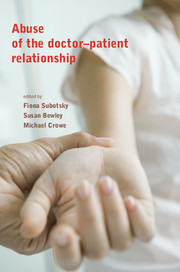Book contents
- Frontmatter
- Contents
- List of figures, tables and boxes
- List of contributors
- Foreword
- Introduction: mapping the territory
- 1 The ethical importance of boundaries to intimacy
- 2 The patient's perspective: impact and treatment
- 3 Teaching ethics and ethical behaviour to medical students
- 4 With the benefit of hindsight: lessons from history
- 5 The prevalence of boundary violations between mental health professionals and their clients
- 6 Psychiatry: responding to the Kerr/Haslam Inquiry
- 7 The general practitioner and abuse in primary care
- 8 Boundaries and boundary violations in psychotherapy
- 9 Sexual therapies: ethical guidelines, vulnerabilities and boundaries
- 10 Obstetrics and gynaecology: a special case?
- 11 Nurses as abusers: a career perspective
- 12 Medical management: governance and sexual boundary issues
- 13 Dealing with offending doctors: sanctions and remediation
- 14 Defending doctors: the protection society's experience
- 15 Regulation and its capacity to minimise abuse by professionals
- 16 The role of the General Medical Council
- Appendix 1 Extract from Vulnerable Patients, Safe Doctors
- Appendix 2 Codes of ethics of psychiatric associations in other countries
- Appendix 3 Guidance from the Council for Healthcare Regulatory Excellence
- Appendix 4 Examples of determinations by the General Medical Council's Fitness to Practise panels
- Appendix 5 Website resources and information
- Index
- Plate section
8 - Boundaries and boundary violations in psychotherapy
Published online by Cambridge University Press: 02 January 2018
- Frontmatter
- Contents
- List of figures, tables and boxes
- List of contributors
- Foreword
- Introduction: mapping the territory
- 1 The ethical importance of boundaries to intimacy
- 2 The patient's perspective: impact and treatment
- 3 Teaching ethics and ethical behaviour to medical students
- 4 With the benefit of hindsight: lessons from history
- 5 The prevalence of boundary violations between mental health professionals and their clients
- 6 Psychiatry: responding to the Kerr/Haslam Inquiry
- 7 The general practitioner and abuse in primary care
- 8 Boundaries and boundary violations in psychotherapy
- 9 Sexual therapies: ethical guidelines, vulnerabilities and boundaries
- 10 Obstetrics and gynaecology: a special case?
- 11 Nurses as abusers: a career perspective
- 12 Medical management: governance and sexual boundary issues
- 13 Dealing with offending doctors: sanctions and remediation
- 14 Defending doctors: the protection society's experience
- 15 Regulation and its capacity to minimise abuse by professionals
- 16 The role of the General Medical Council
- Appendix 1 Extract from Vulnerable Patients, Safe Doctors
- Appendix 2 Codes of ethics of psychiatric associations in other countries
- Appendix 3 Guidance from the Council for Healthcare Regulatory Excellence
- Appendix 4 Examples of determinations by the General Medical Council's Fitness to Practise panels
- Appendix 5 Website resources and information
- Index
- Plate section
Summary
Introduction
Psychotherapists have had particular reasons for being interested in the preservation or loss of boundaries in their treatment interactions. Psychotherapy is an intimate activity, for the most part conducted privately, with little opportunity for direct oversight or social control. Yet it must maintain itself as a separate activity from other intimate interactions between pairs of individuals in order to be defined as a distinct social form. Thus psychotherapists are sensitive to charges that they are ‘just offering friendship’ or are comparable to prostitutes in offering intimate experiences paid on an hourly rate. Psychotherapy also brings a variety of different theories, all of which are relevant to the analysis of human relations and interactions. It is therefore not surprising that psychotherapists, especially psychodynamic psychotherapists, have developed a set of theoretical notions to apply to the analysis of professional relationships and their proper boundaries.
General boundaries
In general medical practice, the boundaries of ethical practice represent an extension of principles of criminal behaviour or civil damage (rape, fraud, etc.) to wider general notions of fiduciary duty and a duty of care. To an extent, this takes into account the idea that a medical professional may, by virtue of his or her position, be able to exert undue influence on a patient. This power should not be abused for personal or professional gain or exercised other than in the service of the patient's best interests and in a way which maintains the dignity and autonomy of the patient.
Boundaries in psychotherapy
In psychotherapy, and particularly psychodynamic psychotherapy, a stricter definition has been adopted, to include deviations from technical standards. These have featured injunctions to maintain high levels of analyst personal reticence and non-disclosure. While the techniques advocated may vary between different schools of therapy, most have adopted the principle that certain technical infractions represent boundary crossing or, worse, boundary violation.
Psychotherapists have tended to view the analysis of the reasons for the crossing of boundaries as more complex than a simple matter of ethical practice or action between two autonomous individuals. Psychodynamic psychotherapists, for example, see both therapist and patient as subject to unconscious forces which may motivate and influence their behaviour whatever their conscious attitude (Box 8.1).
- Type
- Chapter
- Information
- Abuse of the Doctor-Patient Relationship , pp. 91 - 103Publisher: Royal College of PsychiatristsPrint publication year: 2010

